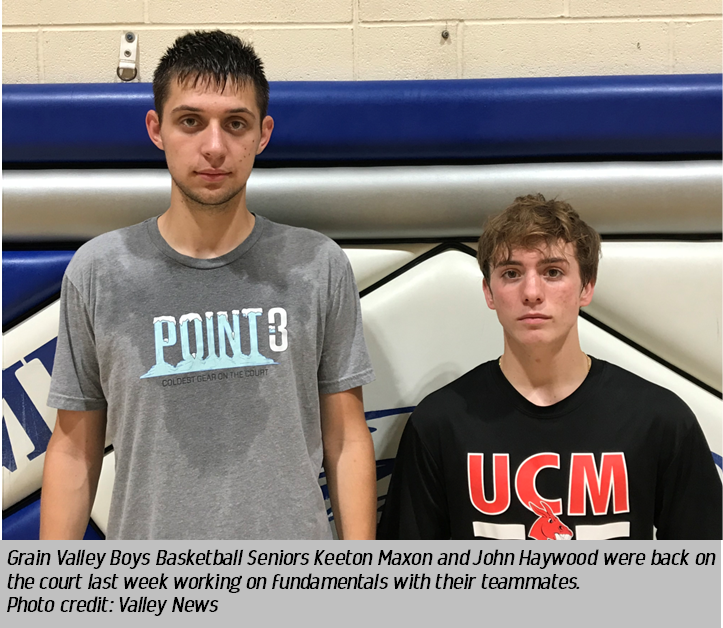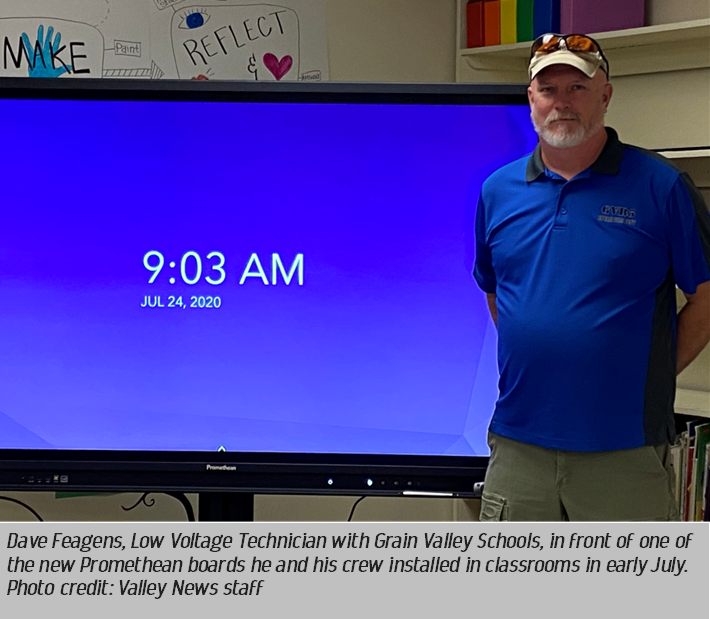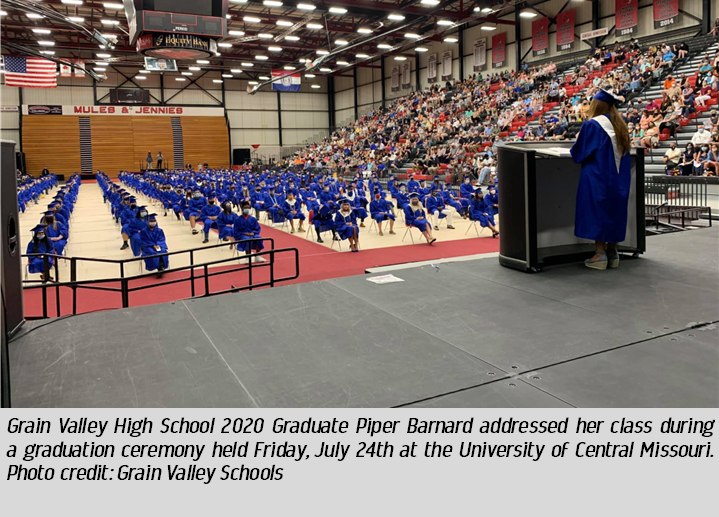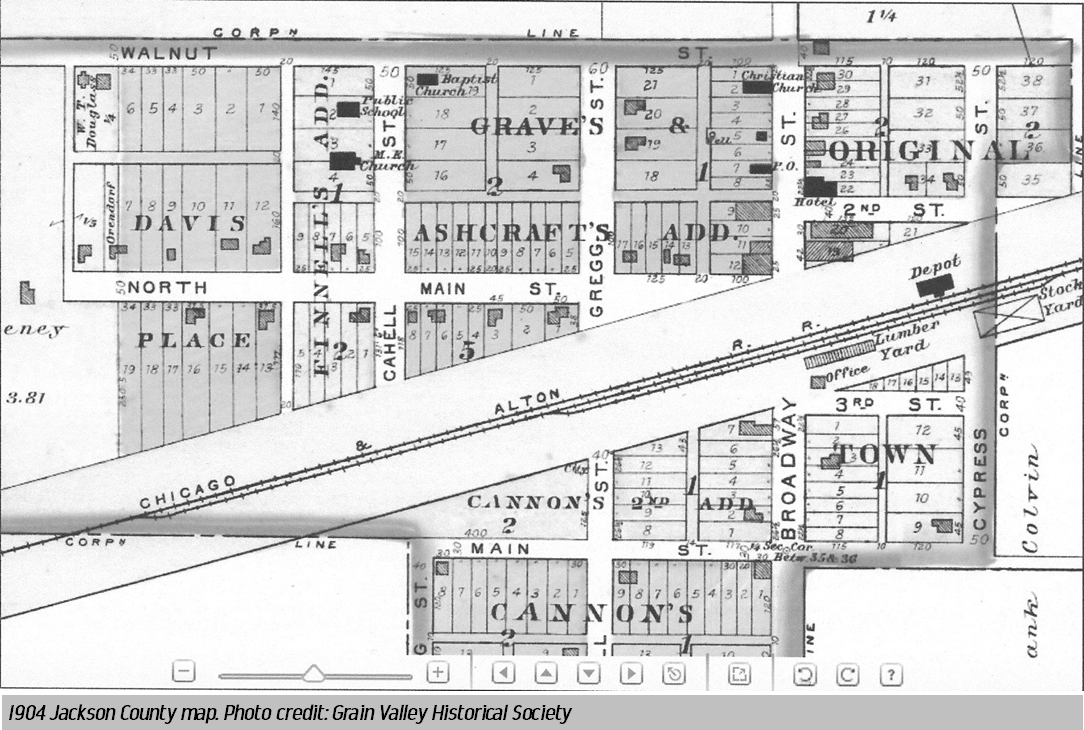|
|
by John Unrein Former University of North Carolina Head Basketball Coach Dean Smith is credited with saying, “There are two important things to do when teaching basketball, praise behavior that you want repeated and knowing what to do with a mistake. You should recognize a mistake, admit it, learn from it, and forget it.”
High school summer basketball camps like the one held at Grain Valley High School the week of July 20th allow coaches to offer affirmation of positive actions on the court as well as constructive questions and criticism that provide growth. Sneakers were squeaking on the hardwood and nets were swishing as the Eagles boys’ basketball team worked on offensive and defensive basketball fundamentals. Floor spacing and passing angle sessions for competitive points was part of the menu of drills directed by Eagles Head Boys Basketball Coach Andy Herbert. The benefits of floor spacing in basketball have become paramount from the professional level of the National Basketball Association all the way down to the high school ranks. By an offense using good spacing in basketball, the defense must cover more territory and has a harder time giving help when recovering to get back to their man or space on the floor they are to defend. Teams who efficiently use floor spacing and motion like the Eagles in their offense are a headache for opposing teams. Defenses must be well conditioned to face the five stressful elements that good floor spacing creates. Basketball Coaches Clipboard online breaks down the strain that terrific floor spacing in motion offenses creates for opposing defenses. First, spacing makes it harder to defend against dribble penetration as the help defenders have further distance to cover when coming off their man. Consequently, spacing makes it harder to defend perimeter shooters, as the help side defender in the paint has more distance to cover in getting back to the shooter. Next, spacing makes it harder to defend post players. Teams that double team the low post will have a more difficult time when players are spaced apart. Good spacing also allows for hi-low passing from one post player to another when players are spread out across the arc. Effective floor spacing also makes it harder to defend cutters maneuvering towards the basket. Lastly, excellent floor spacing makes it harder for a defense to deny passing lanes. Herbert takes a cerebral approach with his players during practice to reinforce understanding so that playing efficiency gets better. A lesson that gives players a breather as well as connecting the mental aspect of the game with the kinesthetic. “Why did you guys win that set? Correct, offensive rebounding. Don’t watch the ball, find a body and get position. You have to be in constant motion when we space the floor. Trust your eyes and compete for the ball if it doesn’t go in,” Herbert said. “If you are the first guy coming off the back screen or flare, you have to move. The ball being dribbled should not interfere with or be in the way of other movement. Also, with spacing we cannot get caught in no man’s land. Get to your landmarks so that we have options and the defense is stretched.” Two returning varsity players paying close attention to Herbert’s instructions at camp are seniors Keeton Maxon and John Haywood. Maxon is getting reps in the low post at camp, while Haywood is running the point for the Eagles, a role that got Haywood more playing time in late last season with the Eagles. “I have enjoyed getting up early and knowing I’m going to get to play basketball with all my friends,” Haywood said. “I miss my older teammates as well. It’s weird being in here without them. No more Caden (Matlon), Josh (Kilpatrick), or AJ (Salisbury). I’m one of the old guys now.” “Ball fakes, familiarizing myself with offensive sets, and learning how to become more comfortable in the paint have been what I’ve tried to work on the most this week at camp.” Haywood concluded, “Defensively, we need to work on closing out better when an opponent drives on us. No easy shots should be allowed against us.” Maxon offered his assessment as well on the week of work put in at camp. “Competing and getting to see everyone again has been special. I have missed the chance to compete and get better,” Maxon said. “Knowing the offense and executing it better has led to more open shots for me. Using my post presence to make better passes has also been an emphasis.” Maxon continued, “Talking more on defense has allowed us to defeat screens better. Knowing our defensive assignment whether we are on the ball or the help side is assisting us in limiting more shots. That will be important to carry into the season.” Anyone who has had the pleasure of setting up a new computer or smart TV in their home can appreciate what a hassle it can be to unbox, install, connect to Wi-Fi, and run endless software updates on these devices. Multiply that experience by 130 and you have some sense of the task completed by Dave Feagens, a Low Voltage Technician with Grain Valley Schools and his crew in late June and early July.
The district purchased new Promethean touchscreen boards to be installed over the summer. With the shutdowns this spring and delayed start of summer school, the installation of the boards became more complicated than expected. Nick Gooch, Assistant Superintendent of Support Services, explained the logistics of installing the boards was one of two big issues. “We had a company quote us to unbox and remove the old Promethean boards and install new boards. The total cost was $40,000 to complete this task. And none of it would have been done prior to summer school. Dave grabbed a couple summer staff and was able to start the process early. This allowed the summer school staff to get the boards early, and him doing this for us saved the district the $40,000,” Gooch said. In his report to the Grain Valley School Board during their July 16th meeting, Gooch took a moment to give a shout out to Feagens. “Feagens and his crew did a 1/3 of the work in a matter of five days. I couldn’t believe he was able to get that work done that quickly. I was thoroughly impressed. They worked really hard, really quickly to get our teachers the equipment they needed,” Gooch said. As Low Voltage Technician, Feagens installs and administers all the security cameras in the district, which stands at around 297 cameras by his count. Feagens is also responsible for handling network drops and technology such as the Promethean boards. As Feagens described it, the labor side of IT. Feagens, who has been with the district for 9 years, emphasized his co-workers made the task of installing the new touchscreens possible. “This year has been a little messed up. We had the shutdown, and then we came back and start into our regular pace, and then the IT department asked us to come have a meeting and that is when this started.” Feagens and his crew got to work, unboxing, building the stands for each screen, setting up and installing firmware, and connecting each to Wi-Fi. The 75-inch touchscreens weigh in at 140 pounds a piece, and bring a new level of flexibility in the classroom. The boards are mounted on mobile carts, so teachers can easily change the arrangement of their classroom as needed. Teachers can sync their laptops to the boards to share lessons or utilize one of the self-supporting programs. The screens are also significantly larger than the prior version, so students can spread out further from the screen, which is particularly important in the age of COVID-19. COVID-19 has not changed the work of the custodial and maintenance staff, but it does add an extra level of awareness, Feagens explained. “As maintenance staff, our main focus will be to be even more aware of our self as well as our environment in terms of what we touch in the space we work in.” As the public continues to debate how to safely return students and teachers to the classroom in the fall, a quiet crew of professionals plans stepped-up efforts to ensure they can do so. “Especially during this time, we often lose sight of the people who actually come in and do that work. Most of the time people don’t see the custodians and operations staff and how important the work they do is to keep students and staff safe, and resolve issues quickly so the class doesn’t have to be interrupted,” Feagens said. Grain Valley High School 2020 graduates were finally able to gather for commencement and toss their caps during a ceremony held at the University of Central Missouri on Friday, July 24th. Students donned masks along with their caps and gowns and were seated to allow for required physical distancing.
Superintendent Marc Snow welcomed students and their parents. “Tonight may not have looked exactly like we all thought it would, or held on the date we intended, but every one of us believes the ceremony and recognition of graduation is something we could not do without. It was important for us to be here and celebrate together,” Snow said. Valley News asked Grain Valley High School Principal Dr. Jeremy Plowman about this graduating class, and Plowman expressed his pride in this class of students. “This class had to overcome so much adversity, especially the past three months. I would not wish this on anyone, but the class of 2020 has handled it with class and grace,” Plowman said. “They have graduated at a unique and tumultuous time in the world. If there is ever a time we need passionate, empathetic, and caring young adults, it is now. This year will always be known for the coronavirus pandemic, but it can also be known for jumpstarting a new leadership in our country. Never will our graduates have as much control over their own destiny as they do now.” Class speaker Piper Barnard, graduating Summa Cum Laude and Missouri Bright Flight Scholar, praised her class for being “brilliantly resilient” and encouraged each student to use this time to embrace their passions and use them to make a difference in the world. “Now is the time for us. Now is the time to figure out what we care about. Now is the time to fall in love with the world and our passions….Now is the time to fail and fall back on our community. Now is the time to embrace diversity,” Barnard said. Grain Valley High School social studies teacher Eric Ball was selected by the student body to speak at the commencement ceremony. Ball gave a rousing speech, asking the students to stand and yell “2020” as he called out their various plans after graduation, including college, military service, mission service, trade schools, and travel. “There is nothing for me to say, because hear their voices. This is what you should hear. Not what the media or the news says. Not out of a sound of pity or a sorry feeling. Not the noise from recent events that have occurred. Hear them,” Ball exclaimed. The 276 graduates were awarded over $4 million in scholarships to post-secondary institutions. “Athletically and activities-wise, this class has had more State qualifiers, conference, and District champions than any previous class. Academically, they continue to be among the top schools in the Kansas City metro area in taking advanced placement classes and being prepared. 98% of this class graduated on time,” Plowman said. Voters head to the polls on August 4th for a primary election, to cast votes for Governor, Lieutenant Governor, Secretary of State, Attorney General, State Treasurer, 6th District U.S. Representative and State Representative District 32.
Locally, Jeff Coleman, Republican Incumbent for MO District 32, will run unopposed, as no candidate has filed for the Democratic, Libertarian, Green, or Constitution parties. Voters will also decide on Constitutional Amendment No. 2, which would adopt Medicaid expansion for persons 19 to 64 years of age with an income level at or below 133% of the federal poverty level. Polls will be open from 6:00am—7:00pm on election day. A sample ballot is provided on page 9 of today’s edition. Additional information on the election and poll locations can be found at www.jcebmo.org. Former Alderman and current Planning and Zoning Commission member Scott Shafer once again utilized the Citizen Participation portion of the Board of Aldermen meeting on July 27th to request the Board address why a property located at 31603 Ryan Road is not hooked up to the City sewer system. Additionally, Shafer called on Mayor Johnston to explain how he plans to deliver on campaign promises, as Shafer described, to “fix more streets and speed up the process”.
“Could you please share how you are planning on doing this and where the money will come from,” Shafer asked. Johnston thanked Shafer but did not address comments. Jack Ryan-Feldman, municipal advisor for Baker Tilly, reviewed the City’s debt management strategy in consideration of current economic trends. Ryan-Feldman provided the Board with several options to restructure current Capital Appreciation Bonds (CABs). One option outlined was a restructuring of $6.5 million in bonds, currently at 4.34% interest. Taking advantage of a rate of 0.92% would yield a savings of $695,000. In other business, the Board approved the final plat approval for the Bush Business Park Re-Plat. The property is located east of the Storage Mar facility and west of Valley Outdoor Equipment on the north side of NW Jefferson Street. The re-plat will contain 4 lots, ranging from 1.5 acres to 2.1 acres in size. The Board also approved the final plat for Greystone Estates Phase II. The Board approved a resolution authorizing the City Administrator to spend funds to repair a sanitary sewer main damaged while Public Works staff installed storm drainage pipes at Cross Creek Park in March. The cost of project is not to exceed $42,000. The next scheduled meeting of the Board of Aldermen is at 7:00pm on Monday, August 10th at City Hall. by Marcia Napier, Grain Valley Historical Society Following the establishment of Grain Valley on September 5, 1878 people began to move into the town to be closer to the Chicago & Alton Railroad. By 1881 the business directory of the town included three doctors; G.U. Keener, James H. Daniels and J. W. Starnes.
Dr. George U. Keener and his wife Lucretia had 10 children, the youngest born in 1876 in Richmond, Missouri. So, I’m thinking that like many of the town’s early residents, he sought an opportunity for success near the railroad. Dr. Keener, was listed four times on the directory as follows: Physician, Minister, Drug Store, and Hotel. I learned that in 1872 he had been appointed as a bishop for the Methodist Episcopal Church for the Boonville District. The family did not remain in Grain Valley for a very long time. From research on Ancestry I learned he was gored by a bull and died in Allenton, St Louis County, Missouri on October 4, 1889. Dr. James Daniels also owned a combination grocery and drug store. The 1880 U. S. Census stated that he was 44 years old and lived in a boarding house run by the Hawkenberrys. He doesn’t appear to have stuck around for very long. Dr. John Starnes and his family were still living in the area in 1900, however when he died in 1909, they were living in Independence, MO. His son was a druggist so one would assume the doctors all dispensed their own medications. Others on the directory included J. H. Cannon, Justice of the Peace, owner of a general store and Postmaster; J. A. Porter, Notary Public; John Graves, general store; Frank Gregg, general store; William Morrow, depot agent; J. A. Spindle, blacksmith; George Kreigel, shoe repair shop; H. A. Hamilton, painter; Joseph Wright, carpenter and Joseph Keshlear, livery stable. One would assume that most of these businesses would have been in the original town although there is much evidence that James Cannon built the first store in Grain Valley on lot seven in what is called the Cannon 2nd addition. Most of the early homes and businesses were built on the north side of the railroad. Therefore, the Graves and Ashcraft Addition was probably the next land to be platted and developed. This addition included the two blocks west of Main Street and north from the railroad to Walnut street. It would appear that the town had a difficult time deciding on street names. The 1877 map identified the street west of the original town as Main Street. The 1904 Map called this street Broadway. The street running west off Broadway was temporarily called North Main Street. The street on the south side of the railroad was called Main Street. Today Broadway is once again Main Street, North Main is Front Street, and Main Street is Harris Street. Are you totally confused? Visit the Historical Society and view the maps on display including the 1924 Jackson County Map that still has a corner of Broadway and North Main! Next week: Learn more about the John Graves, J. H., Mary and William Cannon, and William T. Ashcraft. by Joe Jerek, Missouri Department of Conservation The Missouri Department of Conservation (MDC) has modified the 2020-2021 waterfowl managed hunt process to assure the safety of hunters and staff during the COVID-19 pandemic.
MDC is committed to providing hunting opportunities on managed waterfowl hunting areas throughout the waterfowl season. To allow for flexibility to respond to the state of the pandemic, there will be no pre-season reservations for the 2020-2021 waterfowl season. There will also be no teal season or youth season morning drawings. Procedures for individual conservation areas will be posted on the MDC website closer to season. All reservations, including ADA blinds, will be allocated through the weekly in-season reservation draw. The first application period will open October 20 and results will be announced October 27. The weekly application period opens every Tuesday at 8 a.m. and closes the following Monday at 3 p.m. Throughout the season, hunters will be asked to follow precautionary guidelines to assure the safety of everyone at the site during the morning draw. There will be a sliding scale of procedural levels that could range from no staff-hunter contact at all to close to business as usual. At the start of the season, every conservation area will be assigned to a certain procedural level due to the status of COVID-19 in the county. The decisions will be made in consultation with the appropriate county health department. Throughout the season, an area could move to a more restrictive procedural level depending on the county health department or other COVID-19 related factors. Some details of the procedural levels are as follows: Red Level (very high COVID-19 risk) No staff-hunter contact. No facility use. 100% allocation for Missouri residents only through in-season reservation draw. Hunt positions will be pre-assigned. No poor line or vacancy filling. Orange Level (high COVID-19 risk) Limited facility use and social distancing employed. 100% allocation for Missouri residents only through in-season reservation draw. Hunt parties will be able to select hunt location. No poor line or vacancy filling. Yellow Level (moderate COVID-19 risk) Limited facility use and social distancing employed. 100% allocation for Missouri residents only through in-season reservation draw. Hunt parties will be able to select hunt location. Poor line only for reservation no-shows. Green Level (low COVID-19 risk) Facility use as guidance allows and social distancing employed. 50% allocation through in-season reservation draw. Hunt parties will be able to select hunt location. Poor line for no-shows and 50% of hunt positions. Throughout the season, procedures could change with limited time to notify hunters. In order to receive updates as quickly as possible, please subscribe to the “Waterfowl” email update list at public.govdelivery.com/accounts/MODC/subscribers/new. Interested hunters can also refer to the MDC website as information is available, at huntfish.mdc.mo.gov/hunting-trapping/species/waterfowl/waterfowl-managed-hunts. While this process means a significant change from what hunters are used to, MDC has no plans to make the changes permanent. Back in May, an interdisciplinary team was created to look at the draw procedures and determine the best path forward, keeping hunters and MDC staff safe. This team made the best recommendation they could that balanced hunting opportunity with keeping staff and hunters safe. MDC has designated staff to help answer any questions hunters may have about the changes to this year’s waterfowl season. Please contact the following staff members at the numbers below: Statewide- Lauren Hildreth 573-522-4115 ext. 3259 Joel Porath 573-522-4115 ext. 3188 North Zone- Chris Freeman 660-646-6122 Craig Crisler 660-446-3371 Mike Flaspohler 573-248-2530 Middle Zone- Luke Wehmhoff 573-624-5821 ext. 4662 Gary Calvert 636-441-4554 ext. 4180 South Zone- Lauren Hildreth 573-522-4115 ext. 3259  by Wayne Geiger Several months ago, on a Sunday morning, at the beginning of the stay-at-home order, I began my message to the nine people who were in attendance at the church and those watching online.
I remember saying something like, “Even though I’m a classic introvert and am not into hugging, when this thing is over, I’m giving out free hugs.” Four months later, I’m still waiting for “this thing” to be over and for things to get back to “normal.” Truth be told, I’m missing the human connection and interaction. Complicating the issue is wearing a mask. About sixty-five percent of our language is nonverbal. Having something covering our face minimizes our facial features. We can’t always tell if a person is frowning or if they have a stomachache. Even before this pandemic, studies suggested that half of Americans say they are lonely. In addition, many others report that they have no meaningful relationships. They describe their existence as isolated, marginalized, and sometimes, rejected. Some social scientists and mental health experts have labeled loneliness as a crisis. In a 2019 article by Kay S. Hymowitz, she calls loneliness an epidemic. Loneliness is also dangerous. A study released by Cigna, an insurance company, revealed, “only around half of Americans say they have meaningful, daily face-to-face social interactions.” They claim that loneliness is killing as many people as obesity and smoking. Loneliness is a villain that does not discriminate based up age, gender, or culture. It is a vicious predator that seeks to destroy and has manifested its ugly head in self-harm and even suicide. I was surprised to learn that, when dealing with the issue of suicide, it’s not the younger people who are the most susceptible. Rather, it is senior adults. The National Center for Biotechnology Information notes that the number one risk factor for suicide is when a person suddenly becomes a widow or widower. The NCBI has called the rise in suicides, a “Major public health issue.” The issue of loneliness is really nothing new. In 1974, the music group, “America,” released a song called, “Lonely People.” One of the lines goes like this, “This is for all the lonely people. Thinking that life has passed them by. Don't give up until you drink from the silver cup. And ride that highway in the sky.” But loneliness didn’t begin in the 1970’s. We could go back to the thirteenth century where German emperor Frederick II conducted a bizarre experiment. He wanted to know what language humans would speak if they weren’t taught any language. He placed fifty newborns in the care of nurses who were given strict orders only to feed and bathe the infants. The caretakers were not allowed to speak, hold, or have any other contact with them. The emperor never discovered the answer to what language they would speak. Sadly, none of the infants survived the isolation. As humans, we were built for connection and interaction. It is a matter of life and death. Connection and interaction are so important that isolation has been, and is, used as punishment. I can remember as a kid being sent to my room and had to close the door until being invited out. In our penal system, more than forty states still use solitary confinement as punishment. For the average person, research shows that people without strong social ties are more likely to suffer from major ailments such as heart disease and high blood pressure as well as suffer from lesser ailments such as the common cold. There may be no cure for the common cold, but chicken soup from a friend may help relieve its severity and promote healing. Maybe it’s not the soup. But, why do we need one another? Although some social scientists would suggest that our dire need for social interaction goes back to prehistoric times when humans lived and survived in packs in order to protect the herd, as a pastor, I believe the issue is not sociological, but theological. Way back in the beginning, in the Garden of Eden, God created the first human in His own image. Adam was one of a kind--literally. He was created for intimacy with his Creator and had the world at his feet. But something was missing—or someone. He was surrounded by other animals in pairs, but he was alone. God then said, “It’s not good for the man to be alone” (Gen 2:18). To remedy the pain of this isolation, God created a helpmate and soulmate. That relationship produced other social units such as the family, extended family, and communities. All of it was part of God’s plan and it was good. But we weren’t just created to know each other. Primarily, we were created to know God intimately and personally. The French mathematician and philosopher, Blaise Pascal, put it like this, "There is a God-shaped vacuum in the heart of every man which cannot be filled by any created thing.” We were built to know our Creator and interact with one another. That’s our happy place. Our place of contentment. Isolation, on the other hand, is part of Satan’s strategy. He seeks to divide and conquer. Jesus, the Great Shepherd, leaves the 99 to find the missing one. Satan stealthily attempts to find those who are separated from the fold and in isolation. The Bible says “the devil prowls around like a roaring lion seeking someone to devour” (1 Peter 5:7). Many animal packs, by instinct, learn how to herd in order to protect their young and vulnerable. According to mom.com, “Bison typically run when they sense danger, but when predators approach without warning, bison form a multilayer circle of protection. The females form a ring around the young, and the males form an outer ring surrounding the females.” Humans, on the other hand, often exclaim, “it’s every person for themselves!” or joke, “I don’t have to outrun the bear, I just need to be able to outrun you.” Loneliness is a crisis, but, I believe, preventable. I guess, if the statistics are true, and 50% of us feel alone, then, either these people are all living by themselves, or some of them are living with us—or are at least in our circle. If you think of it that way, perhaps, we’re never really alone. We’re just disconnected while being surrounded by other lonely people. If you fall into this category, my recommendation would be, rather than waiting for someone to come along seeking you—attempt to be proactive. Even in this time of social distancing when many people are not getting out, there are ways to connect. We can connect through the telephone, video, text, and even cards and letters. If you feel the loneliness is severe, seek the assistance of a trained professional. In addition to connecting with one another, to connect to God, we have the wonderful power of prayer and the opportunity to connect to Him through His Word. He’s always there. Jesus says, “Come to me, all who labor and are heavy laden, and I will give you rest” (Matt 11:27). On some levels, we all feel a sense of loneliness and isolation. This is expected—for now. Because of the rebellion in the Garden of Eden, the curse entered and we were cut off from perfect intimacy with God. This was the ultimate social distancing. On this side of heaven, we can certainly “know God” through His Son, Jesus, but there is social distancing. But, a day is coming. The Bible’s comforting words to believers: “We will see His face.” (Rev 22:3-4). The social distancing will end. The masks will come off. On that day, we will enjoy perfect intimacy with our Creator and one another. We’ll even hug. Perhaps the band, America, was on to something when they sang, “Don't give up until you drink from the silver cup. And ride that highway in the sky.” Dr. Wayne Geiger is the Pastor of First Baptist Grain Valley, an Adjunct Associate Professor of Speech, and freelance writer. Parental controls have become a handy tool for parents that are looking to balance their kids, tween, and teen screen time by blocking online sites and setting time limits.
Whenever you limit kids' screen time with their devices, it’s going upset your younger family members. It is important to limit the time your children spend in front of the screen. Most sites and games they play are designed to keep them engaged. Kids always think they know more than their parents and bypassing parental controls.is one of the ways they try to get the upper hand. Want to make sure your kids aren't pulling the wool over your eyes? Here are some ways you can prevent your kids from getting around parental controls. Keep in mind there are many devices you can use for parental controls. You can configure routers to keep your kids in check and there are many apps that you can download on their devices for parental controls. In this digital age we live in, there are many methods kids can use to circumvent parental controls. If you use the following steps, you should be able to have a good handle of making sure you parental controls stay secure. 1. Your kid tries to perform factory reset to their devices. On many devices resetting a smartphone, tablet, computer, or, gaming system back to factory defaults will remove the parental control settings. For any device you are using for parental controls, you should always have an admin account and a user account. This way, the device your kids are using doesn't have the ability to have changes made to it. 2. Your kid tries to access the admin account to change or remove privileges. Kids are crafty and will do anything to get full access to their devices. Whatever you are using for parental controls, make sure you keep the master password safe. To make things even more secure, set up two-factor authentication on your parental control app or device so you are alerted to any unauthorized changes to parental controls. 3. Your kid tries to connect to another Wi-Fi network. If you have an in-home unit like Disney Circle (www.meetcircle.com), Gryphon (www.gryphonconnect.com), ASUS (www.asus.com), or Netgear (www.netgear.com), as long as their devices are connected to your network, you are safe. If you find your kid wants to take their devices over to friends’ homes, they might be using the opportunity to connect to another network to access the stuff they aren't supposed to be accessing. 4. Your kid tries to use a VPN. A VPN or virtual private network is normally used when you are trying to keep your location and places you visit on the web secret. Your kids and set up a VPN (usually on a computer) to get around your home Wi-Fi and device parental control settings. Using app-based parental controls work best because it protects the device regardless of what network they are connected to. 5. Your Kid tries to delete the parental control app. Most kids are smart enough to install and uninstall apps on their devices. Some parental controls software will alert you if the app is removed from a device. For total protection, set up your devices under a family account. Android, Apple, and Windows devices allow you to configure their devices so you can view the activity on all of the devices under that account. Doing so allows you to see if new apps are installed and if apps are being removed from them. Sometimes, no matter what you do, some kids are just extremely motivated to get around those parental control settings. For the ultimate protection, it's sometimes best to go 'old school' and take their devices away at bedtime. It always helps as a backup to parental controls that you look at their devices once a week to view the activity. Unfortunately, there isn't a one solution fits all for parental controls so it's best you get a little familiar with the devices you purchase for your kids so you can keep them safe from all of the threats out on the Internet and make sure they have a good balance with their screen time. Want to ask me a tech question? Send it to [email protected]. If you prefer to connect with me on social media, you can find me on Facebook, Instagram, LinkedIn, and Twitter and watch great tech tip videos on my YouTube channel. I love technology. I've read all of the manuals and I want to make technology fun and easy to use for everyone! If you need on-site or remote tech support for your Windows\Macintosh, computers, laptops, Android/Apple smartphone, tablets, printers, routers, smart home devices, and anything that connects to the Internet, please feel free to contact my team at Integral. My team of friendly tech experts are always standing by to answer your questions and help make your technology useful and fun. Reach out to us a www.callintegralnow.com or phone at 888.256.0829. The following information is derived from the Grain Valley Police Department daily calls for service log for the week of July 15-21, 2020.
|
Categories
All
Archives
July 2024
|
Grain Valley NewsGrain Valley News is a free community news source published weekly online. |
Contact Us |









 RSS Feed
RSS Feed
